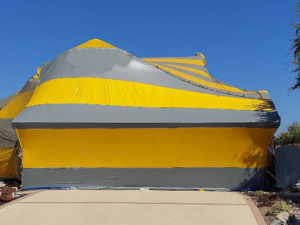When You Should Fumigate - and When You Might Not Need To
 One of the most common questions we hear during termite inspections is: Do we need to fumigate (tent) our home? The answer depends on your unique situation, but these guidelines can help you decide.
One of the most common questions we hear during termite inspections is: Do we need to fumigate (tent) our home? The answer depends on your unique situation, but these guidelines can help you decide.
When You Should Fumigate:
- Swarming Drywood Termites Originating from Inaccessible Areas
If you notice swarming drywood termites but can’t pinpoint their location, fumigation is likely necessary. This applies specifically to drywood termites—not subterranean ones, whose nests are underground and require soil treatment instead. - Droppings from Inside Walls
If you see termite droppings being pushed out of your walls and it has been years since your last fumigation, tenting is recommended. - Activity in Hard-to-Reach Sections of Your Attic
Termite activity in areas like chimney framing or inaccessible sections of your attic are difficult, if not impossible, to treat locally. In these cases, fumigation ensures all termites are eliminated. - Widespread Termite Activity
If termites are active on all four sides of your home and in the attic, it’s a strong indicator of a larger infestation. Visible activity is just the tip of the iceberg—there’s likely even more hidden activity. - Vacant Homes
If your home is vacant, fumigating now can save you hassle later. It’s an opportune time to address termite activity comprehensively without all the hassle. - Fragile Roofs Scheduled for Replacement
If your roof is fragile and due for replacement, fumigation beforehand avoids the risk of damage during treatment and ensures all termite activity is eradicated. - Duplex Situations
If you live in a duplex and need to tent your home, you’ll only be able to proceed if your neighbor agrees to tent as well. You can’t tent half of a shared structure, so take advantage of the opportunity if your neighbor is willing.
When You Might Not Need to Tent:
- Recent Fumigation
If your home was tented within the last five years, visible droppings in areas like the attic or garage may be old remnants. Check your previous termite report to confirm if the activity matches old findings. (If you have fumigated and your inspector found activity in your attic, make sure they come back out after the tent comes down to mask or clean up old termite droppings.) - New Homes
Homes built within the last five years are less likely to have serious infestations unless pre-infested wood was used during construction. - Localized Moisture Issues
If termite activity is limited to areas with moisture problems, addressing the moisture source and applying local treatments may suffice. - Accessible Eave Infestations
Termites in accessible eaves can usually be treated locally. Swarmers in these areas are unlikely to establish new colonies, as most die outside. - Full-Structure Warranty
If you keep a comprehensive termite warranty and schedule regular inspections with a licensed professional, localized treatments can manage most issues without the need for tenting.
Fumigation and Modern Termite Control
While fumigation is California’s primary recommendation for termite control, the decision ultimately rests with you. Much of the regulation around fumigation dates back to 1932, following the Long Beach earthquake when extensive termite damage was discovered in homes.
However, the pest control industry has advanced significantly since then. Modern termiticides are highly effective, and experienced inspectors can often propose alternatives to fumigation when appropriate.
Be cautious with large companies that may push fumigation as the default solution. They often rely on less experienced inspectors who may not have the time to conduct a thorough inspection (critical if not tenting) or expertise to recommend other methods. A knowledgeable, experienced inspector will help you make the best choice for your home.
